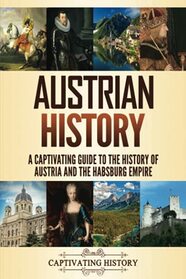This is a combination of two of Captivating History's previous releases, providing an encompassing overview of the Austrians and their history.
HISTORY OF AUSTRIA --
It is amazing to see how many cultures have mixed in Austria -- they have many traces of Germanic, Slavic, Hungarian, Celtic, and even Romans in their makeup. After the Romans left (493 CE), the Babenbergs' noble dynasty emerged over Austrian margraves and dukes. With the extinction of the line (1246 CE), they were eventually succeeded by the German house of Habsburgs (originally of Switzerland). Until 1918, Austria would be tightly wound up in the Habsburg web. Frederick III didn't want to just rule Austria, his goal was, "It is for Austria to rule the world."
Captivating History really has a handle on what caused World War I. After the Austrians were decimated in that war, the ethnic minorities rose up and demanded more autonomy. But their troubles were not behind them, because Hitler came to power in Germany and he wanted the Austrian's industry and raw resources to begin World War II. Hitler took over Austria and renamed it Ostmark, as part of the Third Reich. Again, Captivating History explains the causes of, actions during, and results of WWII. In the years after the wars, Austria has striven to become an oasis of neutrality and safety.
THE HABSBURG EMPIRE --
This is a fascinating family history because the inbreeding of the Habsburgs was legendary, and so were madness and other health issues. The Habsburgs were originally from Switzerland, but moved into Austria and beyond. The Habsburgs ruled the Holy Roman Empire, Hungary, Bohemia, Austria, and more. Habsburg women were married off to be queens of Portugal, the Netherlands, France, Denmark, Sweden, and Norway.
Protestantism even affected the Catholic Habsburgs. The belief was that a country united by its religion was a stable state. By the early 1600s, there were pro-Habsburg Catholics and anti-Habsburg Protestants. These divisions would eventually lead to the Thirty Years' War. When Maria Theresa arrived to rule the Habsburgs, she was a breath of fresh air because she cared about her people more than the infighting within the Habsburgs. By 1777, Maria Theresa had instituted the 'most exemplary education system in Europe.' Maria Therese was the mother of 16 children, including Marie Antoinette.
As an example of fine research, the author brought the Habsburg line all the way to 1997, when the youngest of the Habsburgs was born. Delightedly informative!
HISTORY OF AUSTRIA --
It is amazing to see how many cultures have mixed in Austria -- they have many traces of Germanic, Slavic, Hungarian, Celtic, and even Romans in their makeup. After the Romans left (493 CE), the Babenbergs' noble dynasty emerged over Austrian margraves and dukes. With the extinction of the line (1246 CE), they were eventually succeeded by the German house of Habsburgs (originally of Switzerland). Until 1918, Austria would be tightly wound up in the Habsburg web. Frederick III didn't want to just rule Austria, his goal was, "It is for Austria to rule the world."
Captivating History really has a handle on what caused World War I. After the Austrians were decimated in that war, the ethnic minorities rose up and demanded more autonomy. But their troubles were not behind them, because Hitler came to power in Germany and he wanted the Austrian's industry and raw resources to begin World War II. Hitler took over Austria and renamed it Ostmark, as part of the Third Reich. Again, Captivating History explains the causes of, actions during, and results of WWII. In the years after the wars, Austria has striven to become an oasis of neutrality and safety.
THE HABSBURG EMPIRE --
This is a fascinating family history because the inbreeding of the Habsburgs was legendary, and so were madness and other health issues. The Habsburgs were originally from Switzerland, but moved into Austria and beyond. The Habsburgs ruled the Holy Roman Empire, Hungary, Bohemia, Austria, and more. Habsburg women were married off to be queens of Portugal, the Netherlands, France, Denmark, Sweden, and Norway.
Protestantism even affected the Catholic Habsburgs. The belief was that a country united by its religion was a stable state. By the early 1600s, there were pro-Habsburg Catholics and anti-Habsburg Protestants. These divisions would eventually lead to the Thirty Years' War. When Maria Theresa arrived to rule the Habsburgs, she was a breath of fresh air because she cared about her people more than the infighting within the Habsburgs. By 1777, Maria Theresa had instituted the 'most exemplary education system in Europe.' Maria Therese was the mother of 16 children, including Marie Antoinette.
As an example of fine research, the author brought the Habsburg line all the way to 1997, when the youngest of the Habsburgs was born. Delightedly informative!




